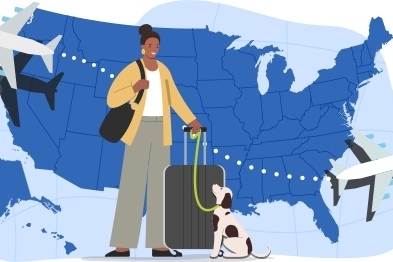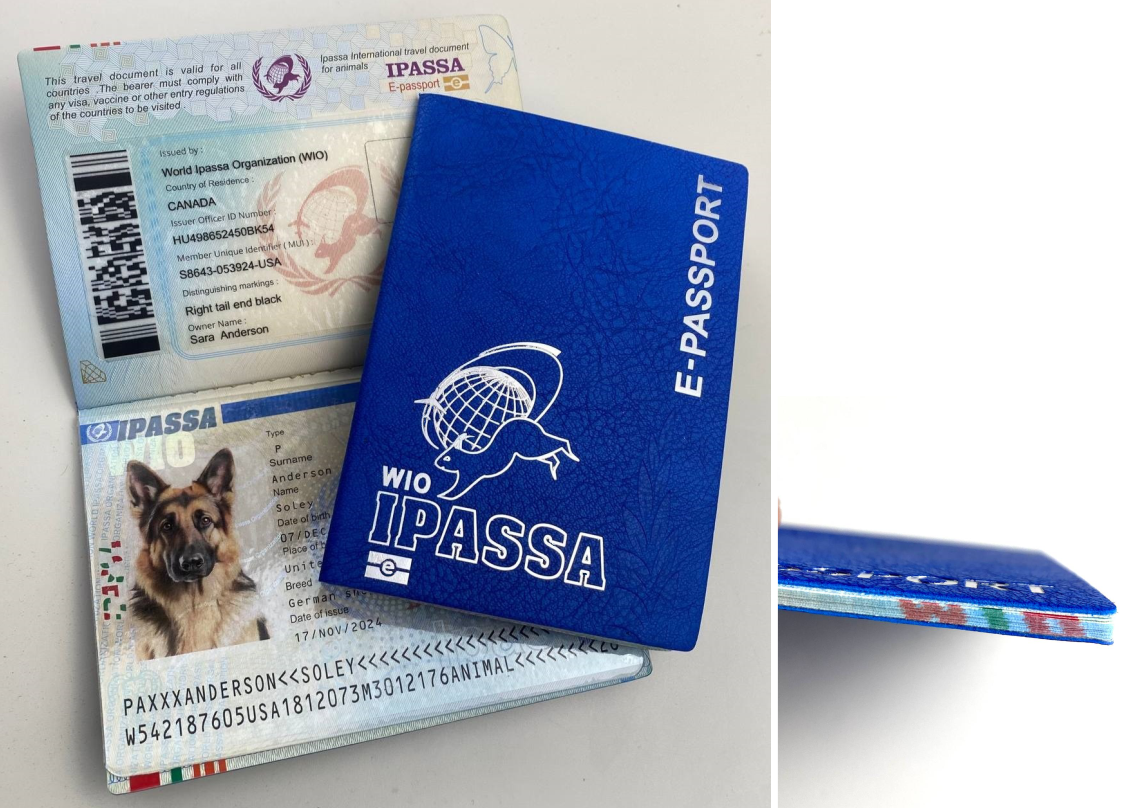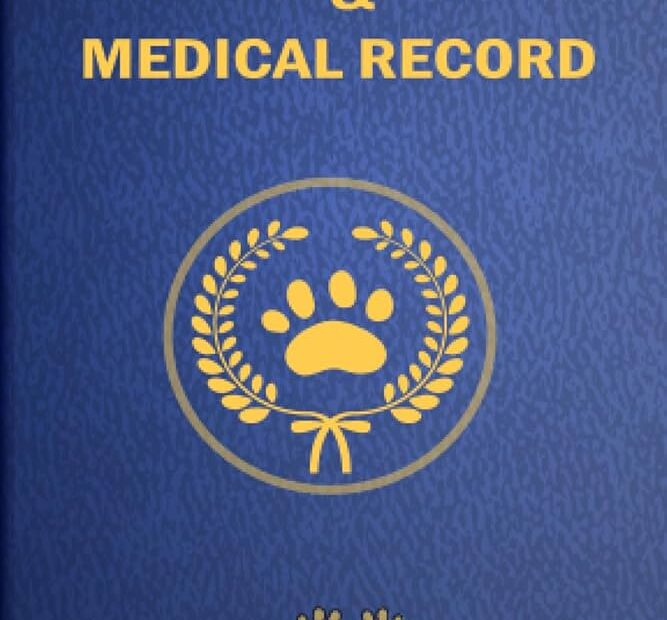Traveling with your pet can be an exciting adventure, but understanding international pet travel requirements is crucial to ensure a smooth journey. Whether you’re relocating or planning a vacation, knowing what rules and regulations apply is essential for your furry friend’s safety and comfort.
You might be wondering about vaccinations, documentation, and airline policies. Navigating these can seem overwhelming, but don’t worry, we’ve got you covered. This article will reveal all you need to know to keep your pet safe and your stress levels low.
Learn how to prepare effectively, avoid common mistakes, and ensure your pet’s journey is as enjoyable as yours. Keep reading to discover how you can make international travel with your pet a breeze.
Also Read

Credit: animalmedicalnc.com
Understanding Pet Travel Regulations
Traveling internationally with pets requires understanding specific regulations. These rules ensure the safety and well-being of your pet during travel. Many countries have unique requirements for pets entering their borders. Knowing these can help avoid complications during travel.
International Guidelines
Most countries follow international guidelines for pet travel. The International Air Transport Association (IATA) sets standards for pet carriers. Pets must be transported in approved carriers. This ensures their safety during flights. Vaccinations are usually necessary. Rabies vaccination is often mandatory. Microchips are recommended for identification. These help in case pets are lost or separated.
Country-specific Rules
Each country has its own pet travel rules. Some countries require pet passports. Others need specific health certificates. Australia has strict quarantine rules. Pets may need to spend time in quarantine upon arrival. The United Kingdom requires an Animal Health Certificate. This certificate must be issued within ten days of travel. Research the destination country’s requirements well in advance. This helps in planning a smooth journey for your pet.
Health And Vaccination Essentials
Traveling internationally with pets requires understanding health and vaccination essentials. Each country has specific requirements that must be met. Ensure your pet’s vaccinations are up-to-date and have the necessary documentation for a smooth journey.
Traveling internationally with your pet is an exciting adventure, but it comes with responsibilities. Ensuring your furry friend is healthy and vaccinated is crucial. Navigating health and vaccination requirements can seem daunting, but with a little preparation, you can make it a smooth process. Let’s break down the essentials to keep your pet safe and compliant with international standards.Required Vaccinations
Different countries have specific vaccination requirements for pets entering their borders. Rabies vaccination is universally mandatory. Some countries demand additional vaccines like distemper or leptospirosis. Check with your destination country’s consulate or official website. This ensures you have the latest vaccination requirements. A well-prepared checklist will save you time and prevent travel delays.Health Certificates
A health certificate is often a non-negotiable document for international pet travel. This certificate is issued by a licensed veterinarian. It confirms your pet is healthy and free from infectious diseases. Most health certificates need to be issued within a specific timeframe before departure. This period can vary from country to country. Consult with your vet well in advance to schedule necessary appointments. Have you ever found yourself scrambling at the last minute? Save yourself the stress by planning ahead. It’s worth it to have everything ready so you can focus on the joy of traveling with your pet. Traveling with pets requires detailed attention to health and vaccination essentials. What steps will you take today to ensure a seamless journey for you and your pet?Pet Identification And Microchipping
Traveling internationally with your pet requires careful preparation. Ensuring your pet is properly identified and microchipped is crucial. This process helps track and verify your pet’s identity during travel. It ensures a safe and smooth journey across borders.
Microchip Standards
Microchips are tiny devices implanted under your pet’s skin. They hold a unique identification number. This number links to your pet’s details in a database. Different countries have varying standards for microchips. Some require ISO-compliant chips. These chips work with international scanners. Ensure your pet’s chip meets these standards.
Tagging And Identification
Tagging complements microchipping for pet identification. A collar with an ID tag is essential. It should display your pet’s name and your contact information. Tags provide instant identification in emergencies. They are visible and easy to read. Ensure your pet wears a tag at all times during travel. Combining microchipping and tagging offers dual protection. It enhances your pet’s security and identification.

Credit: www.aphis.usda.gov
Choosing The Right Travel Carrier
Understanding international pet travel requirements is crucial for safe journeys. Ensure your carrier meets airline standards and offers comfort. Check size, ventilation, and security features to keep your pet relaxed throughout the trip.
When planning international travel with your pet, selecting the right travel carrier is crucial. It’s not just about picking something that looks sturdy; it’s about ensuring your pet’s safety and comfort throughout the journey. The right carrier can make a world of difference, transforming a potentially stressful trip into a smooth adventure for both you and your furry friend.Size And Comfort
First things first, size matters. A carrier that’s too small can cause distress, while one that’s too large may not provide the security your pet needs. Measure your pet’s dimensions, including height, length, and width. The carrier should allow your pet to stand up, turn around, and lie down comfortably. Consider the material too. Opt for breathable fabrics and a soft interior lining to keep your pet cozy. I once chose a carrier with a plush interior for my cat, and it made all the difference in keeping her calm during a long flight.Airline And Transport Compliance
Not all carriers are created equal when it comes to airline regulations. Each airline has its own set of requirements for pet carriers, so you’ll need to do your homework. Check the airline’s website or contact their customer service for specifics about size limits and construction materials. In my experience, some airlines are stricter than others. I once had to switch carriers last minute because mine didn’t comply with a particular airline’s under-seat dimensions. Double-checking compliance can save you from unnecessary stress at the airport. Remember, it’s not just about airline rules. If you’re traveling by train or bus, you’ll need to ensure your carrier meets their standards too. Always have a copy of the carrier’s specifications on hand. This can be handy when verifying compliance with transport officials. Choosing the right travel carrier isn’t just a box to check off your list. It’s about ensuring your pet’s journey is as comfortable and safe as possible. What features do you think your pet would appreciate in a carrier?Booking Flights And Travel Arrangements
Navigating international pet travel requires understanding specific airline policies and country regulations. Ensure your pet has the necessary vaccinations and health certificates. Research quarantine rules and book flights early to accommodate your pet’s needs.
Traveling internationally with your pet can be an exciting adventure, but it does require some planning, especially when it comes to booking flights and making travel arrangements. Understanding the requirements and logistics can ensure a smooth journey for both you and your furry friend. It’s not just about choosing a destination; the preparation is key to a successful trip. Let’s dive into the essential aspects you need to consider.Airline Policies
Before booking your flight, check the airline’s specific policies regarding pet travel. Each airline has unique rules about pet sizes, types allowed in the cabin, or if they need to travel in the cargo hold. Some airlines have restrictions on certain breeds due to health concerns. You might be surprised to know that the time of year can also affect your pet’s travel. Airlines often have temperature restrictions to protect animals during extreme weather conditions. So, it’s crucial to ask yourself: Is my pet’s airline pet-friendly?Pet-friendly Accommodations
Once you’ve sorted your flight, don’t forget to consider where you’ll be staying. Not all accommodations welcome pets, and those that do may have specific conditions. It’s helpful to look for hotels or rentals that provide pet-friendly amenities like pet beds or designated play areas. Websites like BringFido and Booking.com can be great resources to find pet-friendly hotels. Imagine arriving at your destination, only to find out your pet isn’t welcome. Avoid this by ensuring your accommodation details are confirmed in advance. When planning your trip, have you thought about what other pet-related services you might need? Research nearby veterinary services or pet care facilities in case of emergencies. Planning for these details can make your journey stress-free and enjoyable. Remember, the goal is to make sure both you and your pet have a pleasant and safe travel experience.
Credit: www.wjtv.com
Preparing Pets For Travel
Navigating international pet travel requirements demands attention to detail. Ensure vaccinations and health certificates meet destination regulations. Research quarantine rules and airline policies for a seamless journey.
Traveling with pets can be an exciting adventure, but it requires thoughtful preparation to ensure your furry friends are comfortable and safe. Preparing pets for travel involves more than just booking a ticket; it’s about getting them ready for the journey ahead. From behavioral training to acclimating them to carriers, there are several steps you can take to make the process smoother for both you and your pet.Behavioral Training
Behavioral training is crucial for a stress-free travel experience. Begin by teaching basic commands like sit, stay, and come. These can be lifesavers in busy airports or unfamiliar environments. Consider enrolling your pet in a training class. Professional trainers can offer valuable tips and help with specific travel-related behaviors. Practice these commands regularly, rewarding your pet with treats and praise to reinforce good behavior. Have you thought about how your pet reacts to noise or crowds? Exposing them gradually to these elements can build their confidence. The more accustomed they are to new experiences, the less anxious they’ll be on travel day.Acclimating To Carriers
Getting your pet used to a carrier is essential for safe travel. Start by leaving the carrier out in your home, allowing your pet to explore it at their own pace. Make it inviting with soft bedding and their favorite toys. Take short trips to help them get used to being inside. A quick drive around the block can help your pet associate the carrier with positive experiences. Gradually increase the duration as your pet becomes more comfortable. Does your pet seem anxious in the carrier? Try placing a piece of your clothing inside. Your scent can provide comfort and make the carrier feel more familiar. Preparing your pet for travel takes time and patience, but the effort is well worth it. By investing in training and acclimation, you’re setting the stage for a smooth journey. So, are you ready to embark on this adventure with your pet?Managing Pet Anxiety And Stress
Traveling with pets internationally can be stressful. Meeting pet travel requirements is essential to reduce anxiety. Ensure all documents are ready and your pet is comfortable in their travel crate. This helps create a smooth journey.
Traveling internationally with your pet can be exciting yet challenging. One of the biggest concerns is managing your pet’s anxiety and stress. Whether you’re flying across oceans or taking a long car journey, ensuring your pet is calm and comfortable is crucial. Let’s dive into some practical ways you can ease your pet’s travel stress.Calming Techniques
Pets often sense our emotions. If you’re stressed, they might feel it too. Start by staying calm yourself. Prior to travel, create a familiar environment for your pet. Use their favorite blanket or toy. These familiar items can provide comfort and a sense of security. Regular exercise before travel can be beneficial. A long walk or a play session can help burn off excess energy. This makes it easier for your pet to relax during the journey. Consider using natural calming aids. Products like pheromone sprays or calming collars can help soothe anxiety. These are available at most pet stores and are easy to use.Medication Options
Sometimes, calming techniques aren’t enough. Speak to your vet about medication options if your pet struggles with severe anxiety. Vets can prescribe medications that reduce anxiety and help your pet feel more at ease. Always test any medication before the actual travel day. This ensures there are no adverse reactions. Monitor your pet’s behavior closely after administering medication. Discuss the dosage with your vet. The correct dosage is crucial for effectiveness and safety. Remember, medication is just one tool in managing pet anxiety. It should complement other calming strategies. By addressing your pet’s anxiety and stress with these methods, you can make international travel a more enjoyable experience for both you and your furry friend. What steps will you take to ensure your pet travels comfortably?Arrival Procedures And Customs
Traveling internationally with your pet involves several critical steps. Understanding arrival procedures and customs is key. It ensures a smooth transition for both you and your pet. Each country has its own specific requirements. These procedures are designed to protect local ecosystems and public health.
Knowing what to expect can ease the stress of international travel. It also helps in complying with all necessary regulations. Let’s explore what you need to know about quarantine and customs paperwork.
Quarantine Requirements
Many countries have quarantine requirements for pets. These regulations help prevent the spread of diseases. Quarantine periods vary depending on the destination. Some countries may not require quarantine at all. Others might have a mandatory stay for weeks. Check your destination’s rules in advance. This helps in planning your travel itinerary.
Your pet’s health is a priority during this period. Ensure they have all necessary vaccinations. Also, be aware of any health checks they may need. Preparing ahead can help reduce quarantine time.
Customs Paperwork
Completing customs paperwork is essential for international pet travel. Documentation proves your pet meets all health and safety standards. You may need vaccination records or health certificates. Microchip information is often required as well.
Ensure all documents are up-to-date. They must be in the language of your destination country. Missing paperwork can delay your pet’s entry. It may also lead to additional fees. Organize these documents before your departure to avoid any issues.
Emergency Situations And Contingencies
Traveling internationally with pets can be stressful. Emergencies can happen anytime. Knowing what to do is crucial. Proper planning eases anxiety. Understanding contingencies keeps your pet safe. This guide helps prepare for unexpected situations.
Veterinary Contacts
Always have vet contacts ready. Find local vets near your destination. Check their working hours. Ask about emergency services. Write down their phone numbers. Keep them handy for any situation. Reliable vet access is essential.
Emergency Preparedness
Prepare a travel kit for emergencies. Include essentials like food and water. Pack a first-aid kit for your pet. Know your pet’s allergies. Research local emergency shelters. Identify safe spots during travel. Practice emergency drills if possible.
Frequently Asked Questions
What Documents Are Needed For Pet Travel?
To travel internationally with your pet, you need a health certificate, proof of vaccinations, and an import permit. Some countries may require microchip identification and additional documentation. Always check specific requirements for your destination country well in advance to ensure a smooth travel experience.
How Can I Prepare My Pet For Travel?
Start by visiting your veterinarian for a health check-up. Ensure vaccinations are up to date and discuss any travel-related concerns. Acclimate your pet to the travel crate, and pack essentials like food, water, and familiar toys. Research pet-friendly accommodations and transportation options ahead of time.
Are There Quarantine Requirements For Pets?
Yes, some countries have quarantine requirements for pets. This depends on the country’s regulations and your pet’s vaccination status. Quarantine durations vary, ranging from a few days to several weeks. Always verify quarantine rules well in advance to avoid unexpected delays.
Can Pets Travel In-cabin On Airplanes?
Yes, many airlines allow pets to travel in-cabin. However, there are restrictions on size, weight, and breed. It’s essential to check the airline’s specific pet travel policies. Booking in advance and ensuring your pet’s carrier meets airline standards is recommended for a hassle-free journey.
Conclusion
Navigating pet travel rules can seem overwhelming. Each country sets different requirements. Vaccinations, microchips, and paperwork often top the list. Research and planning make the process smoother. Consult with your vet for health checks. Understand quarantine rules for your destination.
Contact airlines for specific pet travel guidelines. Arrange pet-friendly accommodations early. Keep your pet comfortable during the journey. Preparing well ensures a stress-free experience. Your furry friend will thank you. Safe travels for you both!


